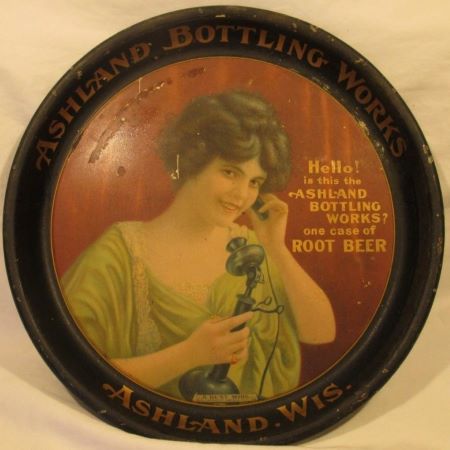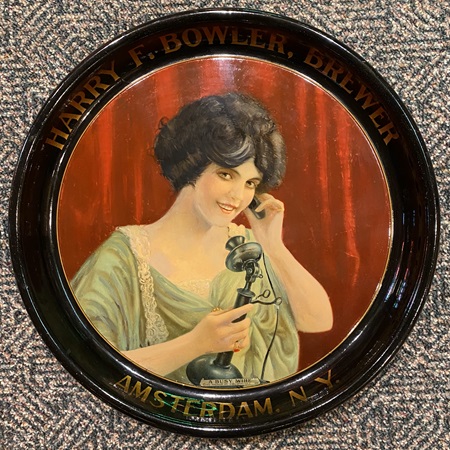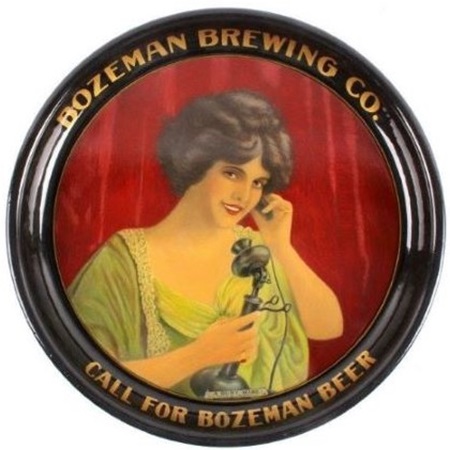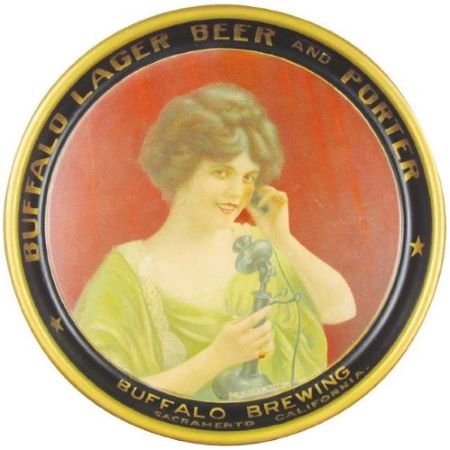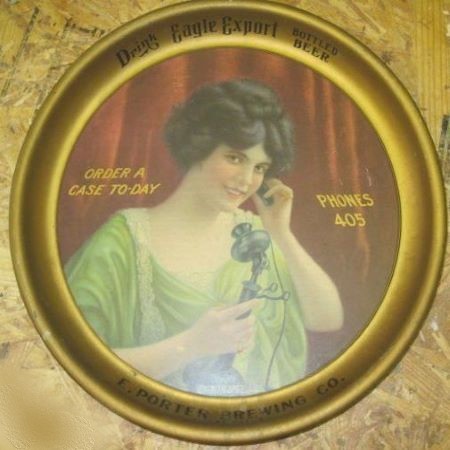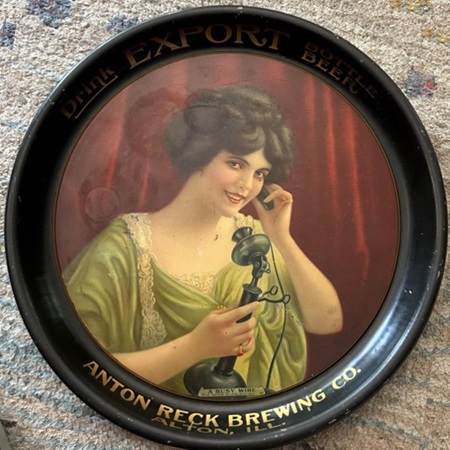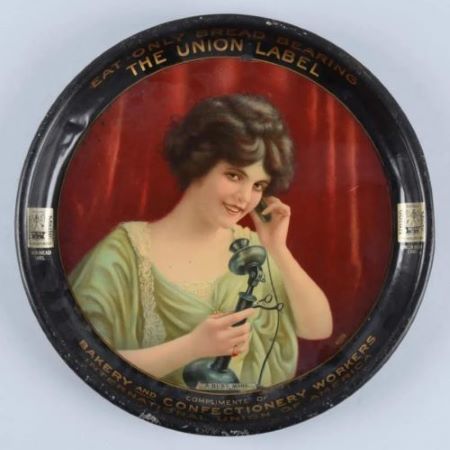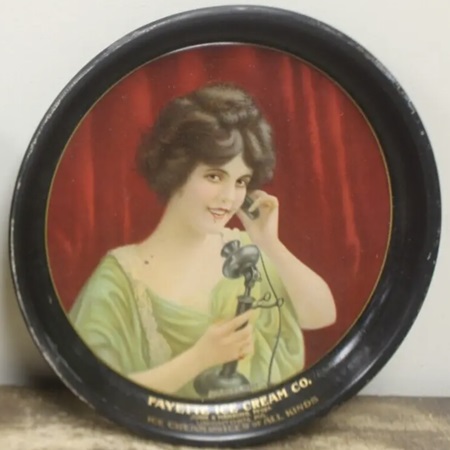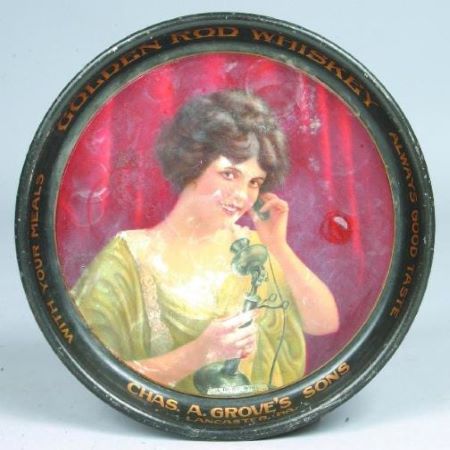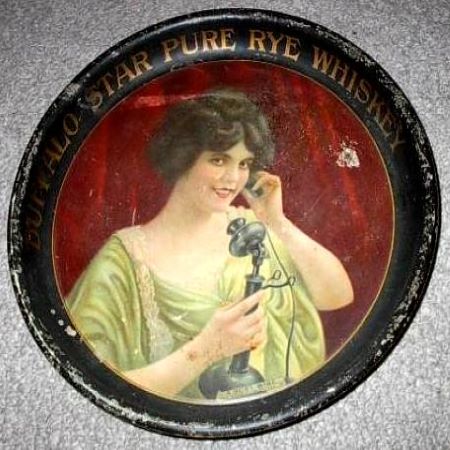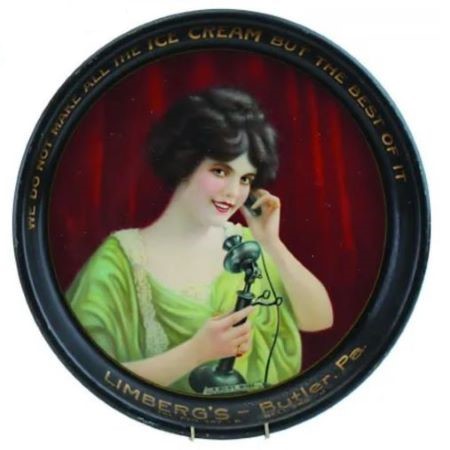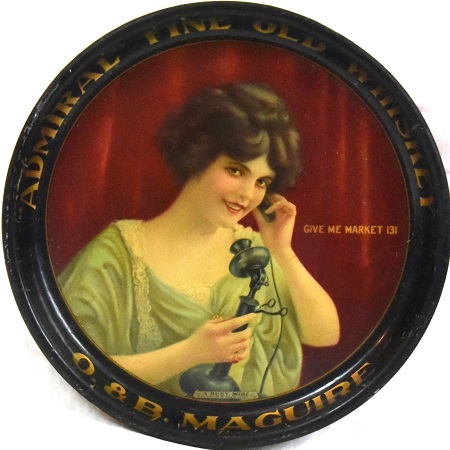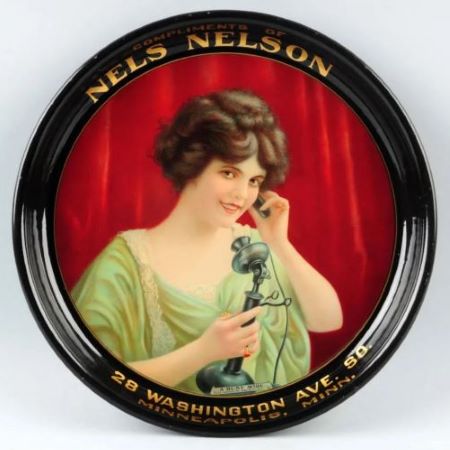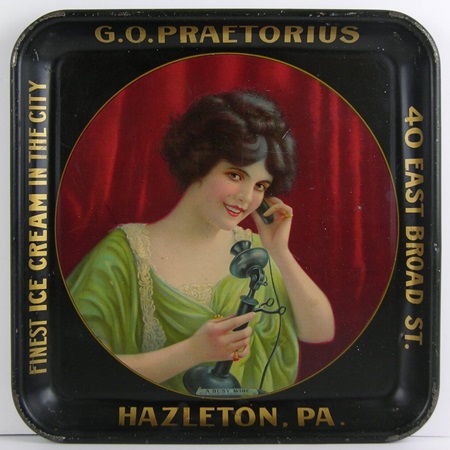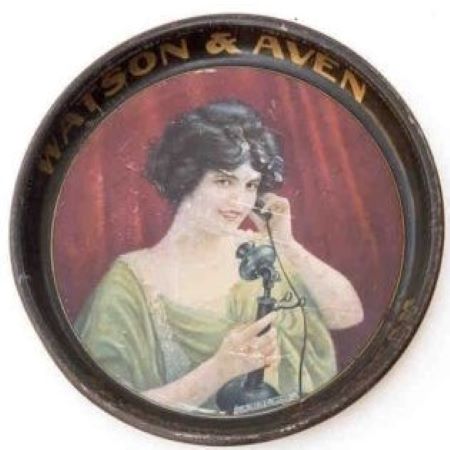The 'Stock' Exchange
American Art Works No. 129 "A Busy Wire"
American Art Works No. 129 "A Busy Wire"
Date: 1913 to 1916
Size: 13"
Type: Pie
Scarcity: Uncommon
Value: $$$ to $$$$
Condition & Brewer Dependent
Size: 13"
Type: Pie
Scarcity: Uncommon
Value: $$$ to $$$$
Condition & Brewer Dependent


Confirmed Brewer used Stock Trays
Non-Beer Related & Non-Tray Uses
When automatic telephone exchanges were introduced, the base of a candlestick also featured a rotary dial, used for signaling the telephone number of an intended call recipient. The version depicted in this design is the earlier, simpler type pre-automated exchanges. In the 1920s and 1930s, telephone technology shifted to the design of more efficient desk top telephones that featured a handset with receiver and transmitter elements in one unit, taking advantage of the advancement in automated exchanges and making the use of a telephone more convenient. However, despite ceasing new production, many candlestick telephones remained in operation, maintained by the telephone companies, throughout the 1940s and into the 1950s.
This design proved to be more popular with non-brewers than it did with brewers, making up three-quarters the examples we have seen. However, none of them took more advantage of the elements of the design than Bozeman Brewing with the clever tag line “Call for Bozeman Beer.”
Sahling does not have an entry in his workbook for this design, nor have we seen any version with an artist’s signature. We can only assume that it was the work of one of Sahling’s colleagues at American Art Works.
Size, Shape & Adveriting Placement
All of the tray versions of this design that we’ve seen are concave pies; among the few sign versions we’ve seen most are tin-over-cardboard and a lone curled corner version. Most often rims are black with gold advertising text; certain examples (e.g., Buffalo Brewing) have gold on the edge of the rim. Gold rims with black advertising text are also known but rare, as is advertising text on the face of the tray.
Hager & Price
Hager does not discuss this design but does include it in his date of introduction table (1913) and includes it in his catalog. There are only a few brewers who used this design; however, ones from E Porter show up fairly frequently. Prices for brewery examples are pretty reasonable with only a few very nice examples approaching $500. Most example go for low three figures and non-breweries tend to be in low double figures.
This design proved to be more popular with non-brewers than it did with brewers, making up three-quarters the examples we have seen. However, none of them took more advantage of the elements of the design than Bozeman Brewing with the clever tag line “Call for Bozeman Beer.”
Sahling does not have an entry in his workbook for this design, nor have we seen any version with an artist’s signature. We can only assume that it was the work of one of Sahling’s colleagues at American Art Works.
Size, Shape & Adveriting Placement
All of the tray versions of this design that we’ve seen are concave pies; among the few sign versions we’ve seen most are tin-over-cardboard and a lone curled corner version. Most often rims are black with gold advertising text; certain examples (e.g., Buffalo Brewing) have gold on the edge of the rim. Gold rims with black advertising text are also known but rare, as is advertising text on the face of the tray.
Hager & Price
Hager does not discuss this design but does include it in his date of introduction table (1913) and includes it in his catalog. There are only a few brewers who used this design; however, ones from E Porter show up fairly frequently. Prices for brewery examples are pretty reasonable with only a few very nice examples approaching $500. Most example go for low three figures and non-breweries tend to be in low double figures.
General
Not quite “Victorian Lady” like the designs in the upper 70s to mid-80s or the emerging “modern woman” like Jeanette (No. 121) or the mother in “Playing Horse (No. 126), No. 129 is a bit of an outlier. She is perhaps the least adorned
woman in the catalog—no jewelry, headbands, hats or flowers. The one exception is a small pinky ring whose potential meaning was shifting from the Edwardian era’s “promise ring” to “ a symbol of self love, which became popular with many suffragettes and first-wave feminists who started wearing them in the 1920s. Even the background is a fairly basic red curtain that is even less intricate than the similar one in “The Invitation” (No. 116). Aside from what appears to be her nightgown (which we suppose was considered fairly racy at the time), the thing that makes this design interesting if the telephone she is holding. While other designs have featured trends in women’s fashion, hairstyles, sports, and an interest in the American West, this design highlights technology.
Despite what we all learned in school, it is not incontrovertible that Alexander Graham Bell invented the telephone; there are a number of viable claimants. In fact, one of his competitors filed a competing patent application the same day Bell did. However, what is clear is that Bell was the most successful in parlaying his invention into commercial success. Something he can thank his financial backers for, as well as an appealing public relations story with the ““Mr. Watson come here, I want you” incident.
“A Busy Wire” depicts the use of a telephone, which was beginning to be available for more widespread home use. Prior to the invention of the telephone switchboard, pairs of telephones were connected directly with each other, which was primarily useful for connecting a home to the owner's business. A telephone exchange provides telephone service for a small area. Either manually by operators, or automatically by machine switching equipment, it interconnects individual subscriber lines for calls made between them. This made it possible for subscribers to call each other at homes, businesses, or public spaces. The U.S. became the world leadership in teledensity (the number of phones per 1000 people) with the rise of many independent telephone companies after the Bell patents expired in 1893 and 1894, rising to almost 3 million telephones in 1904. By 1912, a joint Department of Commerce and Labor Bureau of the Census report on Telephones and Telegraphs revealed that 8.7 million phones existed in the United States out of an estimated population of 95 million.
The candlestick telephone that the woman is holding is a style of telephone that was common from the late 1890s to the 1940s. Candlestick telephones required the nearby installation of a subscriber set (subset, ringer box), which housed the ringer to announce incoming calls and the electric circuitry (capacitor, induction coil, signaling generator, connection terminals) to connect the set to the telephone network.
Not quite “Victorian Lady” like the designs in the upper 70s to mid-80s or the emerging “modern woman” like Jeanette (No. 121) or the mother in “Playing Horse (No. 126), No. 129 is a bit of an outlier. She is perhaps the least adorned
woman in the catalog—no jewelry, headbands, hats or flowers. The one exception is a small pinky ring whose potential meaning was shifting from the Edwardian era’s “promise ring” to “ a symbol of self love, which became popular with many suffragettes and first-wave feminists who started wearing them in the 1920s. Even the background is a fairly basic red curtain that is even less intricate than the similar one in “The Invitation” (No. 116). Aside from what appears to be her nightgown (which we suppose was considered fairly racy at the time), the thing that makes this design interesting if the telephone she is holding. While other designs have featured trends in women’s fashion, hairstyles, sports, and an interest in the American West, this design highlights technology.
Despite what we all learned in school, it is not incontrovertible that Alexander Graham Bell invented the telephone; there are a number of viable claimants. In fact, one of his competitors filed a competing patent application the same day Bell did. However, what is clear is that Bell was the most successful in parlaying his invention into commercial success. Something he can thank his financial backers for, as well as an appealing public relations story with the ““Mr. Watson come here, I want you” incident.
“A Busy Wire” depicts the use of a telephone, which was beginning to be available for more widespread home use. Prior to the invention of the telephone switchboard, pairs of telephones were connected directly with each other, which was primarily useful for connecting a home to the owner's business. A telephone exchange provides telephone service for a small area. Either manually by operators, or automatically by machine switching equipment, it interconnects individual subscriber lines for calls made between them. This made it possible for subscribers to call each other at homes, businesses, or public spaces. The U.S. became the world leadership in teledensity (the number of phones per 1000 people) with the rise of many independent telephone companies after the Bell patents expired in 1893 and 1894, rising to almost 3 million telephones in 1904. By 1912, a joint Department of Commerce and Labor Bureau of the Census report on Telephones and Telegraphs revealed that 8.7 million phones existed in the United States out of an estimated population of 95 million.
The candlestick telephone that the woman is holding is a style of telephone that was common from the late 1890s to the 1940s. Candlestick telephones required the nearby installation of a subscriber set (subset, ringer box), which housed the ringer to announce incoming calls and the electric circuitry (capacitor, induction coil, signaling generator, connection terminals) to connect the set to the telephone network.
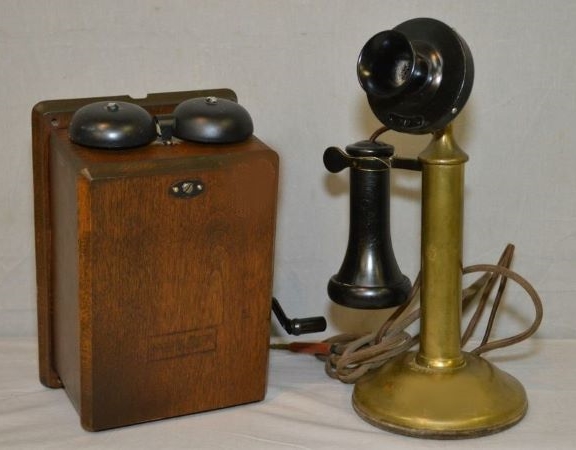
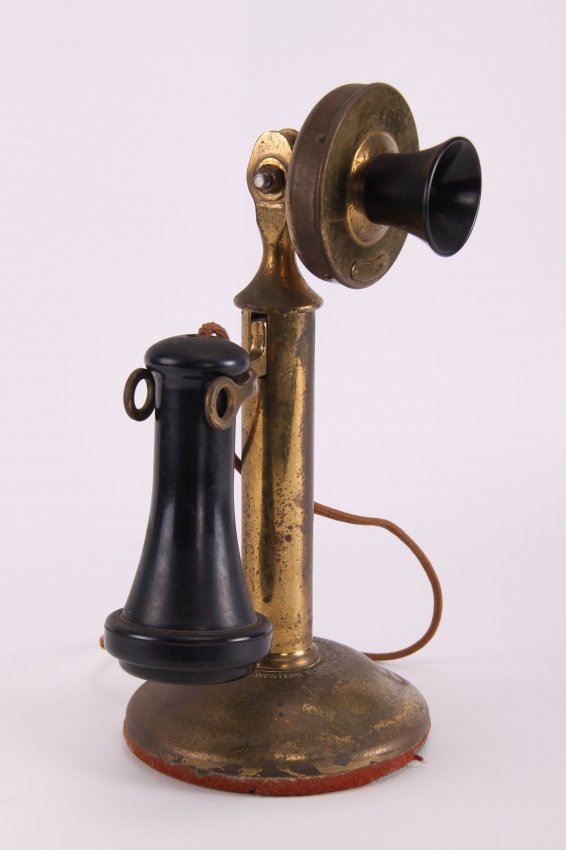
Click the Picture to Return to Meek & Beach Stock Catalog Page
